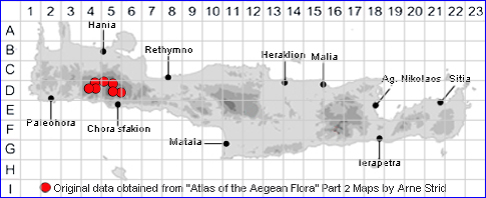
ANCHUSA CESPITOSA
Family:- BORAGINACEAE
Common Name:- None
Synonyms:- None
Meaning:- Anchusa (Gr) Strangler or close. A name given by the Greek playwright
Aristophanes to an alkanet yielding red dye.
Cespitosa (Gr) Tufted, growing in tight groups, the bases of individual
plants touching.
General description:- Cespitose perennial, rough to the touch with stiff bristly
hairs (scabrid-hispid) throughout, with many of the hairs minutely tubercle-based.
Stems:-
a) 1-10 cm.
b) decumbent.
c) forming flat and hard mats up to 50 cm in diam.
Leaves:-
a) 20-50(-75) x 2·5-4 mm.
b) arranged in a basal.rosette (rosulate).
c) linear-oblong, obtuse, often with undulate margins.
d) hispid with tubercle-based setae.
Flowers:-
1) Cymes:
a) often almost stemless (subsessile).
b) dense, with 3-5 flowers.
2) Calyx:
a) 4-6 mm,
b) divided almost to the base into linear, obtuse lobes.
3) Corolla:
a) 10-15 mm in diam.
b) bright blue, with white faucal scales.
c) tube 6-7 mm, c. 1½ times as long as the calyx.
d) limb, 10-12 mm diam.
e) scales, oblong, fringed with hairs (ciliate).
f) stamens inserted in upper half of the tube and slightly overlapping the scales.
Fruit:-
1) Nutlets:
a) c. 2·5 x 3·5 mm.
b) obliquely ovoid.
c) prominently reticulate and rugose-vermcose.
d) greyish.
Key features:-
1) Nutlets wider than long, or hemispherical.
2) Cespitose perennial with stems not more than 10 cm.
Habitat:- Calcareous rocky slopes, soil-pockets among rocks, flat clayey areas
1500-2200 m. Rarely lower in gorges.
Distribution:- Endemic to the Lefka Ori W. Crete. Rare.
.
Flowering time:- Apr-July.
Photos by:- Fotis Samaritakis
Status:-
Conservation status (for threatened species): Rare (R) according to the
Red Data Book of Rare and Threatened Plants of Greece (1995) - Rare (R)
according to IUCN 1997
Protection status (for threatened species): Greek Presidential Decree
67/1981
SPECIES DESCRIPTION
